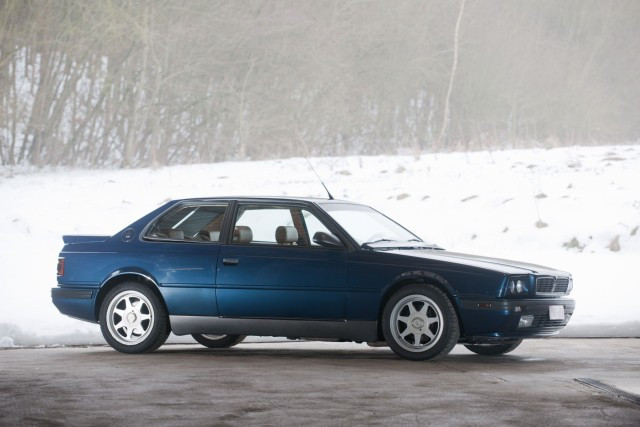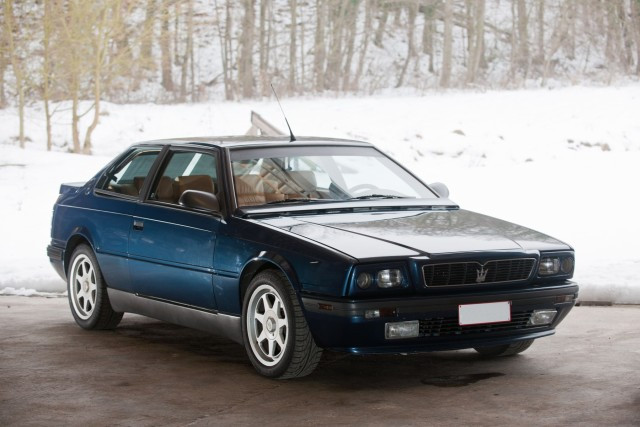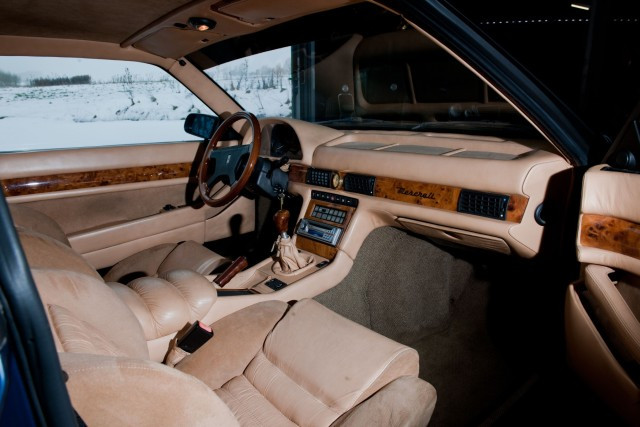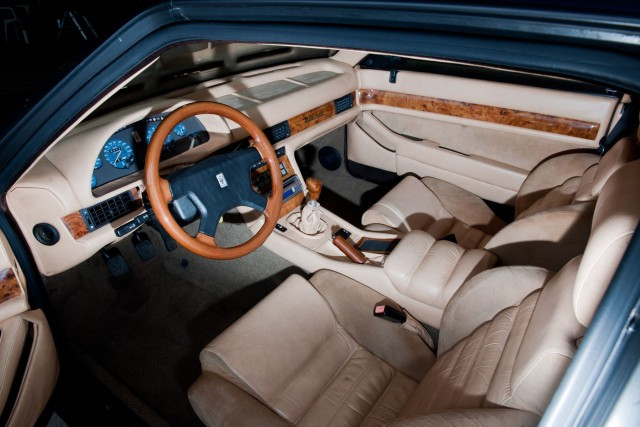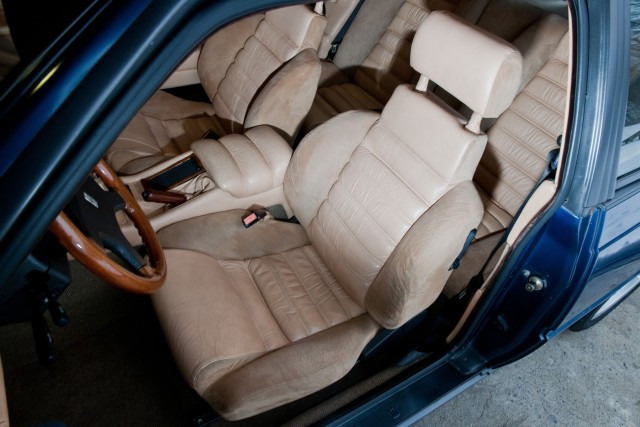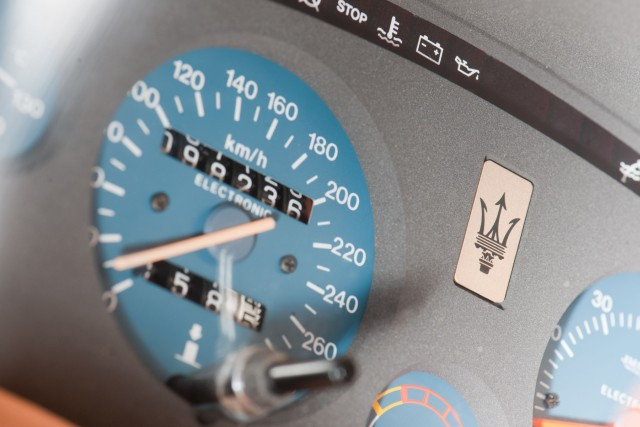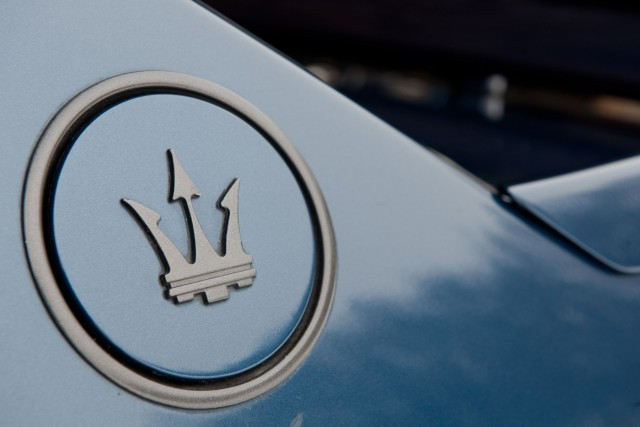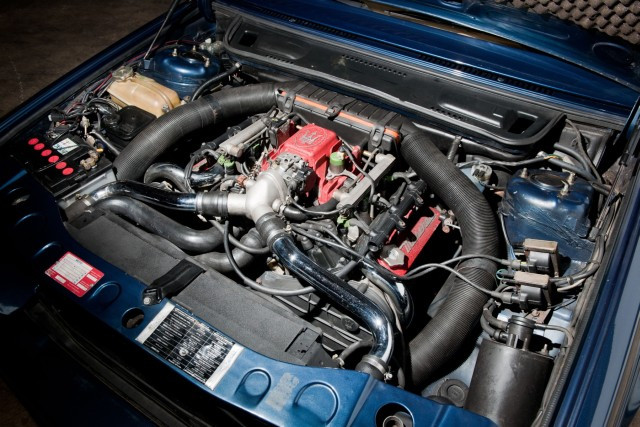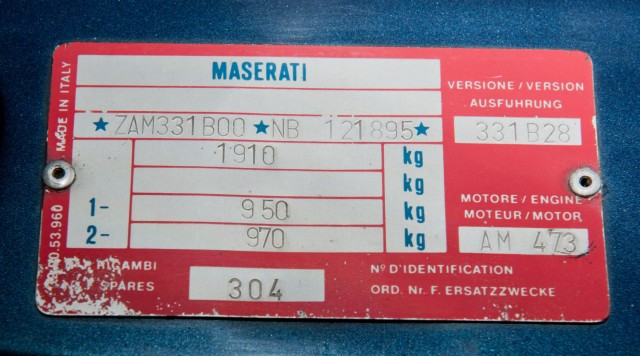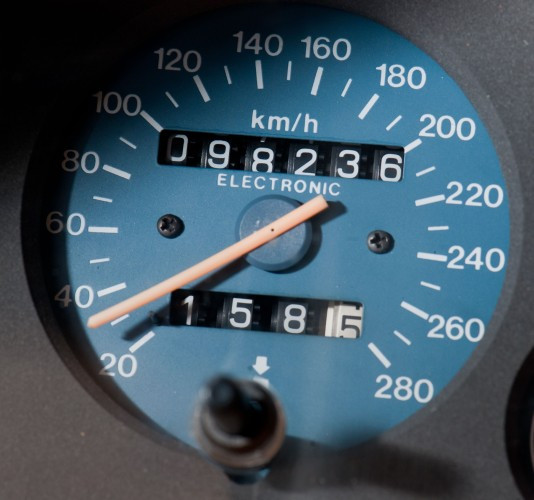Vente Artcurial Motorcars à Rétromobile - 04 février 2011 /Lot 283 1991 MASERATI 222 SR BI-TURBO
1991 MASERATI 222 SR BI-TURBO N° de série : *ZAM33B00*NB121895
Après la reprise, en 1975, de Maserati par Alejandro De Tomaso à Citroën, celui-ci lance la marque dans l'aventure Biturbo. L'idée consistait à introduire sur le marché une voiture de luxe dotée d'un prix raisonnable et d'une cylindrée de moins de 2000 cm3, taxes italiennes obligent. La voiture est étudiée chez De Tomaso en 1980. Une première décision radicale: un V6 Biturbo, une première mondiale ! Tout en alliage léger, équipé de culasses à 2 arbres à cames et trois soupapes par cylindre. Le moteur reste en ligne avec les principes premiers des Maserati: un petit moteur multicylindre très élaboré et très puissant... La voiture est dessinée par Pierangelo Andreani, ingénieur de l'équipe De Tomaso. On peut noter l'influence Italdesign, auteur de la Quattroporte III sortie quelques mois auparavant. La voiture est présentée à la presse fin 1981. C'est rapidement un succès
D'abord équipée d'une alimentation à carburateur en motorisation 2000 cm3, 2500 cm3 et 2800 cm3 (particulièrement pour le marché américain) le modèle évoluera rapidement pour intégrer plusieurs nouveautés: injection électronique et allumage électronique, cartographique couplé à la gestion, elle aussi électronique, des turbos, le tout regroupés dans deux calculateurs. Introduites conjointement, apparaitront deux nouvelles culasses à 4 arbres à cames et à 4 soupapes par cylindre. Puis viendra la suspension réglable depuis le poste de conduite, étudiée avec Koni, 4 positions permettent d'adapter la loi d'amortissement de la voiture à celle du terrain rencontré ou du confort recherché.
Les déclinaisons du modèle sont nombreuses : tout d'abord en deux portes (coupé), elle se déclinera ensuite en 4 portes, en cabriolet (carrossé par Zagato) et même en un élégant petit coupé à deux places nommé " Karif ".
La voiture présentée, vendue neuve en Belgique, est une version équipée du V6 2,8L 18 soupapes, produite entre 1991 et 1993. Dans une livrée bleu nuit et avec un intérieur mariant cuir et alcantara beige, elle totalise 75341 km au compteur. Le propriétaire actuel l'a acquise en 2005 auprès du concessionnaire de la marque d'Anvers. Notre collectionneur nous précise que les amortisseurs, les deux turbos, les freins ont été refaits par les ateliers Officina en Belgique. Elle sera livré avec son manuel d'origine de l'utilisateur.
Il s'agit d'une version construite à environ 340 exemplaires atteignant les 100 km/h en 6,5s. grâce à ses 228ch. Une voiture efficace qui n'a plus rien à voir avec les premières versions biturbos.
Titre de circulation belge.
After Alejandro De Tomaso acquired Maserati from Citroën in 1975, he launched the brand into the Biturbo venture. The idea was to bring to the market a luxury car with a reasonable price and an engine of less than 2,000 cm3. Italian taxes were also to apply. The car was designed by De Tomaso in 1980. The first radical decision that he took was to create a V6 Biturbo, the first of its kind in the world! It was made entirely from lightweight alloy and equipped with a cylinder head with two camshafts and three valves per cylinder. The engine remained in line with key concepts for the Maserati: a small multi-cylinder engine, which was very intricate and very powerful. The car was designed by Pierangelo Andreani, an engineer from the De Tomaso team. We can observe that he was somewhat influenced by Italdesign, designer of the Quattroporte III, which had come out a few months earlier. The car was unveiled to a press audience at the end of 1981. It very quickly became a resounding success.
It was first fitted with a carburettor fuelled engine of 2,000 cm3, 2,500 cm3 and 2,800 cm3 (with the American market specifically in mind) and the model quickly evolved to incorporate several innovations, including electronic injection and ignition, an electronic map integrated into the engine management system, turbos, and everything connected to two control units. Two new cylinder heads with 4 camshafts and 4 valves per cylinder were introduced at the same time. The car was then fitted with adjustable suspension on the dashboard, designed by Koni, and 4 controls to alter the position of the chassis to adapt the car to new terrain or increase driving comfort.
Various models of this car were produced: firstly, the two-door (coupé), then the four-door cabriolet (bodywork by Zagato) and even a small, elegant two-seater Karif coupé.
The car exhibited here was sold new in Belgium. It is equipped with a V6 2.8L, 18 valve engine manufactured between 1991 and 1993. It was originally delivered in midnight blue with mixed leather interior in alcantara beige and had 75,341 km on the clock. The current owner bought it in 2005 at an Anvers dealership. Our collector has verified that the shock absorbers, two turbos and brakes were restored by the Officina workshop in Belgium. It will be delivered with its original user manual.
Approximately 340 units of this model were made and it was able to reach 100 km/h in 6.5s thanks to the 228hp. This is an efficient car, which is wildly different from the very first Biturbo models.
Comes with its Belgian vehicle registration document.
Estimation 12 000 - 16 000 €
Vendu 14 153 €
* Les résultats sont affichés frais acheteur et taxes compris. Ils sont générés automatiquement et peuvent subir des modifications.
Après la reprise, en 1975, de Maserati par Alejandro De Tomaso à Citroën, celui-ci lance la marque dans l'aventure Biturbo. L'idée consistait à introduire sur le marché une voiture de luxe dotée d'un prix raisonnable et d'une cylindrée de moins de 2000 cm3, taxes italiennes obligent. La voiture est étudiée chez De Tomaso en 1980. Une première décision radicale: un V6 Biturbo, une première mondiale ! Tout en alliage léger, équipé de culasses à 2 arbres à cames et trois soupapes par cylindre. Le moteur reste en ligne avec les principes premiers des Maserati: un petit moteur multicylindre très élaboré et très puissant... La voiture est dessinée par Pierangelo Andreani, ingénieur de l'équipe De Tomaso. On peut noter l'influence Italdesign, auteur de la Quattroporte III sortie quelques mois auparavant. La voiture est présentée à la presse fin 1981. C'est rapidement un succès
D'abord équipée d'une alimentation à carburateur en motorisation 2000 cm3, 2500 cm3 et 2800 cm3 (particulièrement pour le marché américain) le modèle évoluera rapidement pour intégrer plusieurs nouveautés: injection électronique et allumage électronique, cartographique couplé à la gestion, elle aussi électronique, des turbos, le tout regroupés dans deux calculateurs. Introduites conjointement, apparaitront deux nouvelles culasses à 4 arbres à cames et à 4 soupapes par cylindre. Puis viendra la suspension réglable depuis le poste de conduite, étudiée avec Koni, 4 positions permettent d'adapter la loi d'amortissement de la voiture à celle du terrain rencontré ou du confort recherché.
Les déclinaisons du modèle sont nombreuses : tout d'abord en deux portes (coupé), elle se déclinera ensuite en 4 portes, en cabriolet (carrossé par Zagato) et même en un élégant petit coupé à deux places nommé " Karif ".
La voiture présentée, vendue neuve en Belgique, est une version équipée du V6 2,8L 18 soupapes, produite entre 1991 et 1993. Dans une livrée bleu nuit et avec un intérieur mariant cuir et alcantara beige, elle totalise 75341 km au compteur. Le propriétaire actuel l'a acquise en 2005 auprès du concessionnaire de la marque d'Anvers. Notre collectionneur nous précise que les amortisseurs, les deux turbos, les freins ont été refaits par les ateliers Officina en Belgique. Elle sera livré avec son manuel d'origine de l'utilisateur.
Il s'agit d'une version construite à environ 340 exemplaires atteignant les 100 km/h en 6,5s. grâce à ses 228ch. Une voiture efficace qui n'a plus rien à voir avec les premières versions biturbos.
Titre de circulation belge.
After Alejandro De Tomaso acquired Maserati from Citroën in 1975, he launched the brand into the Biturbo venture. The idea was to bring to the market a luxury car with a reasonable price and an engine of less than 2,000 cm3. Italian taxes were also to apply. The car was designed by De Tomaso in 1980. The first radical decision that he took was to create a V6 Biturbo, the first of its kind in the world! It was made entirely from lightweight alloy and equipped with a cylinder head with two camshafts and three valves per cylinder. The engine remained in line with key concepts for the Maserati: a small multi-cylinder engine, which was very intricate and very powerful. The car was designed by Pierangelo Andreani, an engineer from the De Tomaso team. We can observe that he was somewhat influenced by Italdesign, designer of the Quattroporte III, which had come out a few months earlier. The car was unveiled to a press audience at the end of 1981. It very quickly became a resounding success.
It was first fitted with a carburettor fuelled engine of 2,000 cm3, 2,500 cm3 and 2,800 cm3 (with the American market specifically in mind) and the model quickly evolved to incorporate several innovations, including electronic injection and ignition, an electronic map integrated into the engine management system, turbos, and everything connected to two control units. Two new cylinder heads with 4 camshafts and 4 valves per cylinder were introduced at the same time. The car was then fitted with adjustable suspension on the dashboard, designed by Koni, and 4 controls to alter the position of the chassis to adapt the car to new terrain or increase driving comfort.
Various models of this car were produced: firstly, the two-door (coupé), then the four-door cabriolet (bodywork by Zagato) and even a small, elegant two-seater Karif coupé.
The car exhibited here was sold new in Belgium. It is equipped with a V6 2.8L, 18 valve engine manufactured between 1991 and 1993. It was originally delivered in midnight blue with mixed leather interior in alcantara beige and had 75,341 km on the clock. The current owner bought it in 2005 at an Anvers dealership. Our collector has verified that the shock absorbers, two turbos and brakes were restored by the Officina workshop in Belgium. It will be delivered with its original user manual.
Approximately 340 units of this model were made and it was able to reach 100 km/h in 6.5s thanks to the 228hp. This is an efficient car, which is wildly different from the very first Biturbo models.
Comes with its Belgian vehicle registration document.
Estimation 12 000 - 16 000 €
Vendu 14 153 €
* Les résultats sont affichés frais acheteur et taxes compris. Ils sont générés automatiquement et peuvent subir des modifications.
Lot 283
1991 MASERATI 222 SR BI-TURBO
Lot 283
Vendu 14 153 € [$]
1991 MASERATI 222 SR BI-TURBO N° de série : *ZAM33B00*NB121895
Après la reprise, en 1975, de Maserati par Alejandro De Tomaso à Citroën, celui-ci lance la marque dans l'aventure Biturbo. L'idée consistait à introduire sur le marché une voiture de luxe dotée d'un prix raisonnable et d'une cylindrée de moins de 2000 cm3, taxes italiennes obligent. La voiture est étudiée chez De Tomaso en 1980. Une première décision radicale: un V6 Biturbo, une première mondiale ! Tout en alliage léger, équipé de culasses à 2 arbres à cames et trois soupapes par cylindre. Le moteur reste en ligne avec les principes premiers des Maserati: un petit moteur multicylindre très élaboré et très puissant... La voiture est dessinée par Pierangelo Andreani, ingénieur de l'équipe De Tomaso. On peut noter l'influence Italdesign, auteur de la Quattroporte III sortie quelques mois auparavant. La voiture est présentée à la presse fin 1981. C'est rapidement un succès
D'abord équipée d'une alimentation à carburateur en motorisation 2000 cm3, 2500 cm3 et 2800 cm3 (particulièrement pour le marché américain) le modèle évoluera rapidement pour intégrer plusieurs nouveautés: injection électronique et allumage électronique, cartographique couplé à la gestion, elle aussi électronique, des turbos, le tout regroupés dans deux calculateurs. Introduites conjointement, apparaitront deux nouvelles culasses à 4 arbres à cames et à 4 soupapes par cylindre. Puis viendra la suspension réglable depuis le poste de conduite, étudiée avec Koni, 4 positions permettent d'adapter la loi d'amortissement de la voiture à celle du terrain rencontré ou du confort recherché.
Les déclinaisons du modèle sont nombreuses : tout d'abord en deux portes (coupé), elle se déclinera ensuite en 4 portes, en cabriolet (carrossé par Zagato) et même en un élégant petit coupé à deux places nommé " Karif ".
La voiture présentée, vendue neuve en Belgique, est une version équipée du V6 2,8L 18 soupapes, produite entre 1991 et 1993. Dans une livrée bleu nuit et avec un intérieur mariant cuir et alcantara beige, elle totalise 75341 km au compteur. Le propriétaire actuel l'a acquise en 2005 auprès du concessionnaire de la marque d'Anvers. Notre collectionneur nous précise que les amortisseurs, les deux turbos, les freins ont été refaits par les ateliers Officina en Belgique. Elle sera livré avec son manuel d'origine de l'utilisateur.
Il s'agit d'une version construite à environ 340 exemplaires atteignant les 100 km/h en 6,5s. grâce à ses 228ch. Une voiture efficace qui n'a plus rien à voir avec les premières versions biturbos.
Titre de circulation belge.
After Alejandro De Tomaso acquired Maserati from Citroën in 1975, he launched the brand into the Biturbo venture. The idea was to bring to the market a luxury car with a reasonable price and an engine of less than 2,000 cm3. Italian taxes were also to apply. The car was designed by De Tomaso in 1980. The first radical decision that he took was to create a V6 Biturbo, the first of its kind in the world! It was made entirely from lightweight alloy and equipped with a cylinder head with two camshafts and three valves per cylinder. The engine remained in line with key concepts for the Maserati: a small multi-cylinder engine, which was very intricate and very powerful. The car was designed by Pierangelo Andreani, an engineer from the De Tomaso team. We can observe that he was somewhat influenced by Italdesign, designer of the Quattroporte III, which had come out a few months earlier. The car was unveiled to a press audience at the end of 1981. It very quickly became a resounding success.
It was first fitted with a carburettor fuelled engine of 2,000 cm3, 2,500 cm3 and 2,800 cm3 (with the American market specifically in mind) and the model quickly evolved to incorporate several innovations, including electronic injection and ignition, an electronic map integrated into the engine management system, turbos, and everything connected to two control units. Two new cylinder heads with 4 camshafts and 4 valves per cylinder were introduced at the same time. The car was then fitted with adjustable suspension on the dashboard, designed by Koni, and 4 controls to alter the position of the chassis to adapt the car to new terrain or increase driving comfort.
Various models of this car were produced: firstly, the two-door (coupé), then the four-door cabriolet (bodywork by Zagato) and even a small, elegant two-seater Karif coupé.
The car exhibited here was sold new in Belgium. It is equipped with a V6 2.8L, 18 valve engine manufactured between 1991 and 1993. It was originally delivered in midnight blue with mixed leather interior in alcantara beige and had 75,341 km on the clock. The current owner bought it in 2005 at an Anvers dealership. Our collector has verified that the shock absorbers, two turbos and brakes were restored by the Officina workshop in Belgium. It will be delivered with its original user manual.
Approximately 340 units of this model were made and it was able to reach 100 km/h in 6.5s thanks to the 228hp. This is an efficient car, which is wildly different from the very first Biturbo models.
Comes with its Belgian vehicle registration document.
Estimation 12 000 - 16 000 €
Vendu 14 153 €
* Les résultats sont affichés frais acheteur et taxes compris. Ils sont générés automatiquement et peuvent subir des modifications.
Après la reprise, en 1975, de Maserati par Alejandro De Tomaso à Citroën, celui-ci lance la marque dans l'aventure Biturbo. L'idée consistait à introduire sur le marché une voiture de luxe dotée d'un prix raisonnable et d'une cylindrée de moins de 2000 cm3, taxes italiennes obligent. La voiture est étudiée chez De Tomaso en 1980. Une première décision radicale: un V6 Biturbo, une première mondiale ! Tout en alliage léger, équipé de culasses à 2 arbres à cames et trois soupapes par cylindre. Le moteur reste en ligne avec les principes premiers des Maserati: un petit moteur multicylindre très élaboré et très puissant... La voiture est dessinée par Pierangelo Andreani, ingénieur de l'équipe De Tomaso. On peut noter l'influence Italdesign, auteur de la Quattroporte III sortie quelques mois auparavant. La voiture est présentée à la presse fin 1981. C'est rapidement un succès
D'abord équipée d'une alimentation à carburateur en motorisation 2000 cm3, 2500 cm3 et 2800 cm3 (particulièrement pour le marché américain) le modèle évoluera rapidement pour intégrer plusieurs nouveautés: injection électronique et allumage électronique, cartographique couplé à la gestion, elle aussi électronique, des turbos, le tout regroupés dans deux calculateurs. Introduites conjointement, apparaitront deux nouvelles culasses à 4 arbres à cames et à 4 soupapes par cylindre. Puis viendra la suspension réglable depuis le poste de conduite, étudiée avec Koni, 4 positions permettent d'adapter la loi d'amortissement de la voiture à celle du terrain rencontré ou du confort recherché.
Les déclinaisons du modèle sont nombreuses : tout d'abord en deux portes (coupé), elle se déclinera ensuite en 4 portes, en cabriolet (carrossé par Zagato) et même en un élégant petit coupé à deux places nommé " Karif ".
La voiture présentée, vendue neuve en Belgique, est une version équipée du V6 2,8L 18 soupapes, produite entre 1991 et 1993. Dans une livrée bleu nuit et avec un intérieur mariant cuir et alcantara beige, elle totalise 75341 km au compteur. Le propriétaire actuel l'a acquise en 2005 auprès du concessionnaire de la marque d'Anvers. Notre collectionneur nous précise que les amortisseurs, les deux turbos, les freins ont été refaits par les ateliers Officina en Belgique. Elle sera livré avec son manuel d'origine de l'utilisateur.
Il s'agit d'une version construite à environ 340 exemplaires atteignant les 100 km/h en 6,5s. grâce à ses 228ch. Une voiture efficace qui n'a plus rien à voir avec les premières versions biturbos.
Titre de circulation belge.
After Alejandro De Tomaso acquired Maserati from Citroën in 1975, he launched the brand into the Biturbo venture. The idea was to bring to the market a luxury car with a reasonable price and an engine of less than 2,000 cm3. Italian taxes were also to apply. The car was designed by De Tomaso in 1980. The first radical decision that he took was to create a V6 Biturbo, the first of its kind in the world! It was made entirely from lightweight alloy and equipped with a cylinder head with two camshafts and three valves per cylinder. The engine remained in line with key concepts for the Maserati: a small multi-cylinder engine, which was very intricate and very powerful. The car was designed by Pierangelo Andreani, an engineer from the De Tomaso team. We can observe that he was somewhat influenced by Italdesign, designer of the Quattroporte III, which had come out a few months earlier. The car was unveiled to a press audience at the end of 1981. It very quickly became a resounding success.
It was first fitted with a carburettor fuelled engine of 2,000 cm3, 2,500 cm3 and 2,800 cm3 (with the American market specifically in mind) and the model quickly evolved to incorporate several innovations, including electronic injection and ignition, an electronic map integrated into the engine management system, turbos, and everything connected to two control units. Two new cylinder heads with 4 camshafts and 4 valves per cylinder were introduced at the same time. The car was then fitted with adjustable suspension on the dashboard, designed by Koni, and 4 controls to alter the position of the chassis to adapt the car to new terrain or increase driving comfort.
Various models of this car were produced: firstly, the two-door (coupé), then the four-door cabriolet (bodywork by Zagato) and even a small, elegant two-seater Karif coupé.
The car exhibited here was sold new in Belgium. It is equipped with a V6 2.8L, 18 valve engine manufactured between 1991 and 1993. It was originally delivered in midnight blue with mixed leather interior in alcantara beige and had 75,341 km on the clock. The current owner bought it in 2005 at an Anvers dealership. Our collector has verified that the shock absorbers, two turbos and brakes were restored by the Officina workshop in Belgium. It will be delivered with its original user manual.
Approximately 340 units of this model were made and it was able to reach 100 km/h in 6.5s thanks to the 228hp. This is an efficient car, which is wildly different from the very first Biturbo models.
Comes with its Belgian vehicle registration document.
Estimation 12 000 - 16 000 €
Vendu 14 153 €
* Les résultats sont affichés frais acheteur et taxes compris. Ils sont générés automatiquement et peuvent subir des modifications.
Détails de la vente
Vente : 1957
Date : 04 févr. 2011 19:00
Date : 04 févr. 2011 19:00
Contact
Ordres d’Achat
& Enchères par Téléphone
Kristina Vrzests
Tél. +33 1 42 99 20 51
bids@artcurial.com
